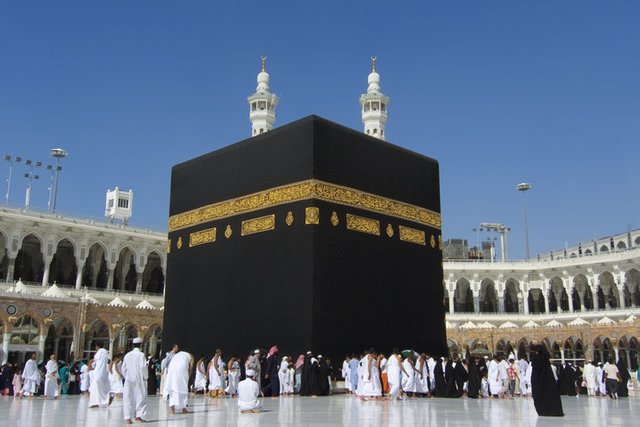When and how Islam started
teachers guide
Timeline of Islam
Home
Discussion and Activities
Glossary
Beliefs and Daily Lives of Muslims
Islam Timeline
The start of Islam is marked in the year 610, following the first revelation to the prophet Muhammad at the age of 40. Muhammad and his followers spread the teachings of Islam throughout the Arabian peninsula. Soon after the death of the prophet Muhammad, there were military expeditions, called "futuhat," or literally "openings," into what is now Egypt and other parts of North Africa. In other parts of the world, Islam spread through trade and commerce. The following is a brief timeline that highlights some of the major occurrences in Islam's development, as well as the geographical spread of Islam to some of the countries featured in the film.
570 C.E. Muhammad is born in Mecca. He comes from a noble family and is well-known for his honesty and upright character.
610 C.E. According to Muslim belief, at the age of 40, Muhammad is visited by the angel Gabriel while on retreat in a cave near Mecca. The angel recites to him the first revelations of the Quran and informs him that he is God's prophet. Later, Muhammad is told to call his people to the worship of the one God, but they react with hostility and begin to persecute him and his followers.
622 C.E. After enduring persecution in Mecca, Muhammad and his followers migrate to the nearby town of Yathrib (later to be known as Medina), where the people there accepted Islam. This marks the "hijrah" or "emigration," and the beginning of the Islamic calendar. In Medina, Muhammad establishes an Islamic state based on the laws revealed in the Quran and the inspired guidance coming to him from God. Eventually he begins to invite other tribes and nations to Islam.
630 C.E. Muhammad returns to Mecca with a large number of his followers. He enters the city peacefully, and eventually all its citizens accept Islam. The prophet clears the idols and images out of the Kaaba and rededicates it to the worship of God alone.
633 C.E. Muhammad dies after a prolonged illness. The Muslim community elects his father-in-law and close associate, Abu Bakr, as caliph, or successor.
638 C.E. Muslims enter the area north of Arabia, known as "Sham," including Syria, Palestine, Lebanon and Iraq.
641 C.E. Muslims enter Egypt and rout the Byzantine army. Muslims consider their conquest as the liberation of subjugated people, since in most instances they were under oppressive rule.
655 C.E. Islam begins to spread throughout North Africa.
661 C.E. Imam Ali is killed, bringing to an end the rule of the four "righteous caliphs": Abu Bakr, Umar, Uthman, and Ali. This also marks the beginning of the Umayyad rule.
711 C.E. Muslims enter Spain in the west and India in the east. Eventually almost the entire Iberian Peninsula is under Islamic control.
732 C.E. Muslims are defeated at Potiers in France by Charles Martel.
750 C.E. The Abbasids take over rule from the Umayyads, shifting the seat of power to Baghdad.
1000 C.E. Islam continues to spread through the continent of Africa, including Nigeria, which served as a trading liaison between the northern and central regions of Africa.
1099 C.E. European Crusaders take Jerusalem from the Muslims. Eventually Muslims defeat the Crusaders and regain control of the holy land.
1120 C.E. Islam continues to spread throughout Asia. Malaysian traders interact with Muslims who teach them about Islam.
1299 C.E. The earliest Ottoman state is formed in Anatolia, Turkey.
1453 C.E. Ottomans conquer the Byzantine seat of Constantinople and change its name to Istanbul.
Circa 1800 C.E. Approximately 30 percent of Africans forced into slavery in the United States are Muslim.
1870-1924 C.E. Muslim immigrants from the Arab world voluntarily come to the United States until the Asian Exclusion Act is passed in 1924.
World War I ends with the defeat and dissolution of the Ottoman Empire, which was the last of the Islamic empires. Many regions populated by Muslims in Africa and Asia are colonized by Europeans. Traditional religious ways of life are threatened and, in some cases, destroyed.
1930 C.E. The Nation of Islam is created in the U.S. by W. D. Fard. It is based on some Islamic ideas, but contains innovations, such as the appointment or declaration of Elijah Muhammad as a prophet.
1948 C.E. The state of Israel is created. Some Palestinian and Lebanese refugees flee to the United States, among them, Muslims and Christians.
1952 C.E. The McCarren-Walter Act relaxes the U.S. ban on Asian immigration. Muslim students come to the U.S. from many nations.
1965 C.E. Revisions of immigration law further open the doors for Muslim immigration.
1975 C.E. Wallace D. Muhammad, the son of Elijah Muhammad, takes over leadership of the Nation of Islam after his father's death and brings most of his followers into mainstream Islam. He later creates the Muslim American Society, which attracts many members, most of whom are African-American.
1979 C.E. The Iranian Revolution results in the establishment of the Islamic Republic of Iran, the first attempt at an Islamic state in the modern era.
